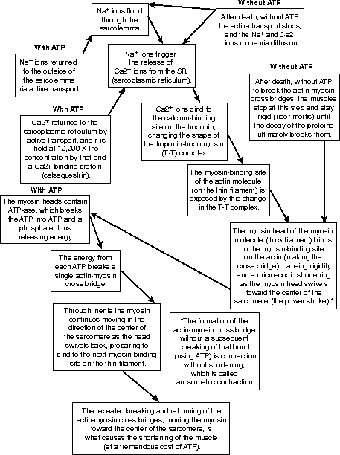Anatomy and Physiology: Out of Breath?
Out of Breath?
This ATP use requires the presence of numerous mitochondria. I mentioned that each glucose molecule yielded enough energy to convert 38 ADP to 38 ATP, and I also explained that an additional 62 percent of the energy in the glucose was released as heat. This should explain why you sweat so much when you exercise, what with all that excess heat!
In addition to the glucose being delivered by the blood, muscle cells also store glucose in the form of the polymer glycogen. Glucose utilization also requires oxygen. In addition to the oxygen delivered by the blood, muscle cells can also hoard oxygen due to a hemoglobin-like molecule called myoglobin that can be found in the sarcoplasm, and which gives raw meat its color.
Despite all these precautions, sometimes the muscle cells demand more energy than the body can provide. Having enough glucose usually isn't the problem, but to get the maximum amount of ATP your cells also need oxygen. As you exercise, and your oxygen needs increase, you start to breathe more quickly, and more deeply, in order to get the oxygen, and thus the ATP, to all those sarcomeres. If you can't get enough oxygen, you get the sensation of being “out of breath,” which is the body's way of saying slow down!

Figure 8.8This flow chart illustrates both the steps of normal contraction and of rigor mortis. (©Michael J. Vieira Lazaroff)
If you continue to exercise, the muscle cells will start to process glucose in the absence of oxygen. The first step, glycolysis, is the same, producing only 2 ATP. The pyruvic acid is then converted, because of the lack of oxygen, into lactic acid (in a process known as lactic acid fermentation). The lactic acid buildup, which means a drop in the pH of the sarcoplasm, is painful. Pain is, of course, the body's way of telling you to stop what you are doing. When your muscles are feeling this pain, they are working too hard in the absence of oxygen. No oxygen means you are only getting 1/19 the amount of energy, and you are in danger of running out of energy! That seems like a good point to stop!
Rigor Mortis
Medical Records
Have you ever wondered why dissection specimens are so stiff? If you think about it, if rigor mortis follows the loss of ATP, and the only way to reverse it (or rather continue forward to a loosening of the cross-bridges, as it is impossible to go back) is to have the muscles decay, and the specimen has been preserved to prevent decay, you have effectively trapped the specimen in a state of permanent rigor mortis!
What will happen when you die? Rather than getting into a lengthy discussion of the soul, let's concentrate on what we know happens to the body. Life is spent in a relentless search for food (energy); this search doesn't end when you are unconscious or in a coma, for you will start to break down your own tissues, just to get your precious requirements of ATP. When you die, some of this breakdown will continue automatically, for longer in the big muscles than in the small ones, but what happens when you ultimately run out of ATP?
Let's break it down, as it were: (1) the active transport stops as soon as the ATP runs out, (2) the Na+ and Ca2+ flood into the sarcoplasm, (3) the Ca2+ unlocks the T-T complex, (4) the myosin-binding site on the actin forms a cross-bridge with the myosin heads onthe thick filament, but (5) without any more ATP those cross-bridges cannot be broken. The muscle gets stiff, but it doesn't contract. This is the essence of rigor mortis. The only thing that ultimately breaks those cross-bridges in the absence of ATP is the breakdown of the proteins when they decay.

Excerpted from The Complete Idiot's Guide to Anatomy and Physiology © 2004 by Michael J. Vieira Lazaroff. All rights reserved including the right of reproduction in whole or in part in any form. Used by arrangement with Alpha Books, a member of Penguin Group (USA) Inc.
To order this book direct from the publisher, visit the Penguin USA website or call 1-800-253-6476. You can also purchase this book at Amazon.com and Barnes & Noble.







